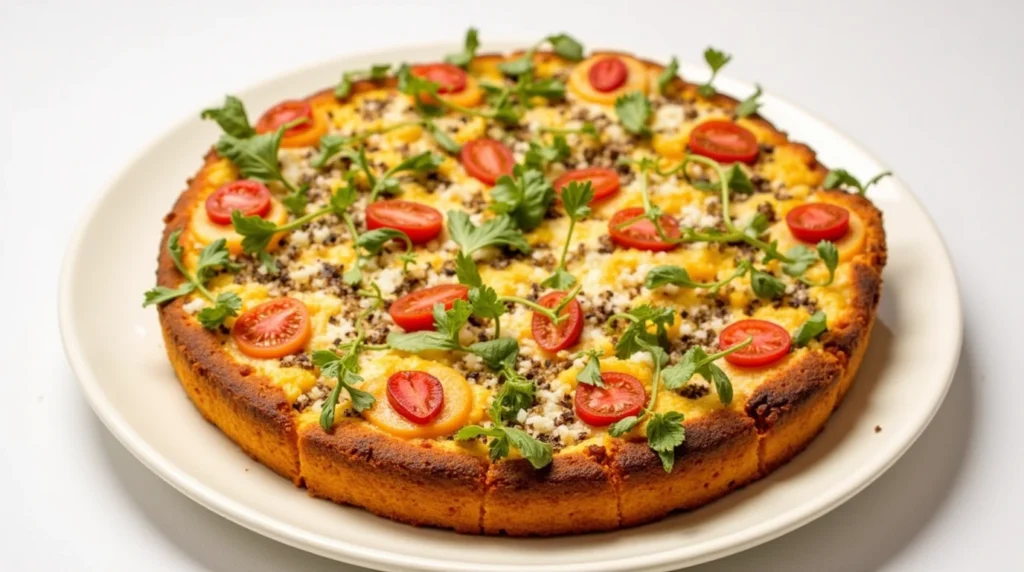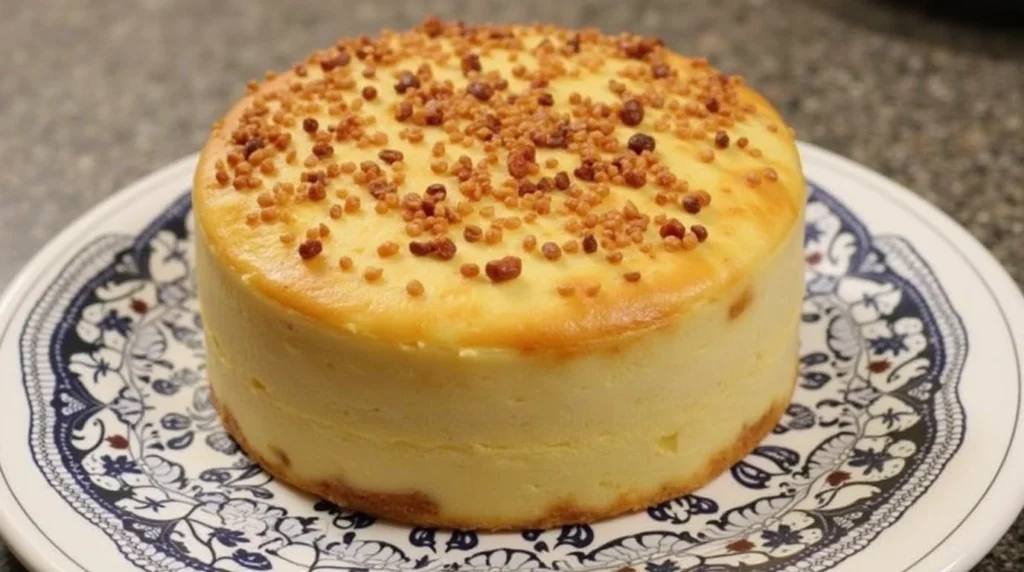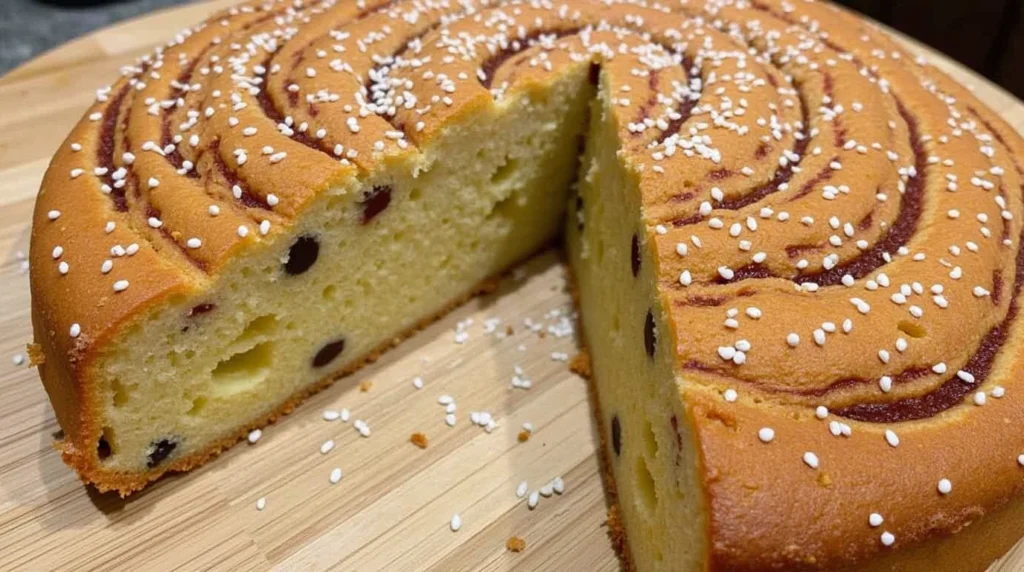Introduction

Imagine this: You’re sitting around a table with your family, laughter filling the air, and the scent of freshly baked lemon wafting through the room. This is what Torta della Nonna represents—a slice of nostalgia wrapped in golden pastry and creamy custard. For many Italians, it’s more than just a dessert; it’s a taste of home, tradition, and love passed down by generations of nonnas (grandmothers). And today, I’m here to guide you step-by-step so you can recreate this iconic treat right in your own kitchen. Whether you’re an experienced baker or someone who’s just starting out, making Torta della Nonna will be easier—and more rewarding—than you think.
What Is Torta della Nonna?
A Classic Italian Lemon Custard Tart
Torta della Nonna is a beloved Italian dessert that combines a buttery shortcrust pastry base with a rich, tangy lemon custard filling, topped off with toasted pine nuts and a dusting of powdered sugar. Its origins trace back to Italy’s rural kitchens, where grandmothers would whip up this simple yet indulgent cake for special occasions. The key ingredients include:
- Fresh lemons for zest and juice
- Butter and flour for the flaky crust
- Pine nuts for crunch and texture
This combination creates a harmonious balance of flavors and textures that make every bite unforgettable.
Cultural Significance of Torta della Nonna
Why is Torta della Nonna often called “Grandma’s Cake”? Because it embodies the warmth and care associated with Italian nonnas. In Italy, food isn’t merely sustenance—it’s a way of connecting people. Families gather over homemade meals and desserts like Torta della Nonna during holidays, birthdays, and Sunday lunches. It’s not just about the recipe but the memories tied to it.
Did you know? Traditional recipes are often handed down verbally from one generation to the next, preserving their authenticity.
Comparison with Other Italian Desserts
While Tiramisu and Panettone may steal the limelight internationally, Torta della Nonna holds its own charm. Unlike Tiramisu, which relies on mascarpone and coffee, Torta della Nonna focuses on citrusy freshness. Compared to Panettone, it offers a simpler preparation process while still delivering bold flavors. Here’s how they stack up:
| Dessert | Main Ingredients | Flavor Profile | Prep Time |
|---|---|---|---|
| Torta della Nonna | Shortcrust, lemon custard | Tangy, sweet | Moderate |
| Tiramisu | Mascarpone, coffee, ladyfingers | Rich, creamy | High |
| Panettone | Candied fruits, raisins | Sweet, fruity | Very high |
Essential Ingredients for Torta della Nonna
Before diving into the recipe, let’s break down the essential components. Each ingredient plays a crucial role in achieving the perfect Torta della Nonna.
Shortcrust Pastry Base
The foundation of your tart, the shortcrust pastry, needs to be light and crisp. To achieve this:
- Use cold butter and ice water when mixing.
- Chill the dough after kneading to prevent shrinking during baking.
- Roll it evenly to ensure uniform thickness.
Rich Lemon Custard Filling
Lemon is the star of this dessert, adding brightness and zing to the otherwise creamy filling. Key tips:
- Zest only the outermost layer of the lemon peel to avoid bitterness.
- Add a pinch of salt to enhance the sweetness of the custard.
- Let the filling cool completely before assembling the tart.
Pine Nuts and Powdered Sugar Garnish
Pine nuts add a delightful crunch, while powdered sugar lends elegance. Toast the pine nuts lightly to bring out their nutty aroma. Sprinkle the sugar generously but evenly for visual appeal.
Optional Variations
If you want to experiment, consider these options:
- Replace pine nuts with slivered almonds for a nut-free alternative.
- Fold in chocolate chips or fresh berries for a modern twist.

Step-by-Step Guide to Making Torta della Nonna
Now comes the fun part—putting everything together! Follow these steps carefully for best results.
Prepare the Shortcrust Pastry
- Combine flour, sugar, salt, and grated lemon zest in a bowl.
- Cut in cold butter until the mixture resembles coarse crumbs.
- Gradually add ice water, mixing until the dough forms a ball.
- Wrap in plastic and refrigerate for at least 30 minutes.
- Roll out the dough and press it into a tart pan.
Create the Lemon Custard Filling
- Whisk eggs, sugar, cornstarch, and milk in a saucepan.
- Cook over medium heat, stirring constantly, until thickened.
- Stir in lemon zest, juice, and vanilla extract.
- Transfer to a bowl and cover with plastic wrap to cool.
Assemble and Bake Your Tart
- Pour the cooled custard into the prepared pastry shell.
- Smooth the surface with a spatula.
- Bake at 350°F (175°C) for 30–35 minutes or until golden brown.
- Allow the tart to cool completely before garnishing.
Finish with Pine Nuts and Powdered Sugar
- Spread toasted pine nuts evenly across the top.
- Sift powdered sugar gently over the entire tart.
- Slice and serve with a side of espresso or cappuccino.
Tips for Perfecting Your Torta della Nonna
Even seasoned bakers encounter hiccups sometimes. Here are some expert tips to help you nail this recipe.
Common Mistakes to Avoid
- Overworking the dough, which can lead to tough pastry.
- Overbaking the tart, resulting in dry edges.
- Skipping the cooling step for the custard, causing cracks.
Storage and Serving Suggestions
Store your Torta della Nonna in an airtight container at room temperature for up to three days. Serve it chilled or at room temperature, paired with:
- Espresso or macchiato
- A scoop of vanilla gelato
- Fresh fruit slices for added color
Gluten-Free Adaptations
For those avoiding gluten, substitute all-purpose flour with a high-quality gluten-free blend. Ensure the blend contains xanthan gum for structure. Test small batches first to confirm consistency.
Fun Facts About Torta della Nonna
Historical Background
The name “Torta della Nonna” reflects its humble beginnings as a grandmother’s creation. While no single origin story exists, most agree it originated in central and southern Italy. Regional variations exist, such as using almond paste instead of pine nuts.
Celebrating Italian Cuisine
Italy boasts a rich culinary heritage rooted in simplicity and quality ingredients. Torta della Nonna showcases Mediterranean staples like lemons, olive oil, and nuts. Famous Italian pastry shops like Pasticceria San Giuseppe in Naples continue to honor traditional recipes.
Modern Popularity
In recent years, social media platforms have fueled global interest in authentic Italian recipes. Hashtags like #TortaDellaNonna and #ItalianBakingChallenge inspire countless home cooks worldwide.
Essential Ingredients for Torta della Nonna
Shortcrust Pastry Base – The Foundation of Your Tart
The shortcrust pastry forms the backbone of Torta della Nonna, so getting it right is essential. Here’s a deeper dive into what makes this crust special:
- Why Use Cold Butter? Cold butter creates pockets of air as it melts during baking, resulting in a flaky texture.
- How Much Flour Should You Use? For a standard recipe, use about 2 cups of all-purpose flour. Adjust based on humidity or altitude.
- Tips for Rolling Out Dough: Dust your work surface lightly with flour to prevent sticking. Roll from the center outward to maintain even thickness.
Here’s a quick checklist for perfecting your shortcrust:
- Measure ingredients accurately.
- Chill dough for at least 30 minutes before rolling.
- Prick the bottom of the crust with a fork before filling to avoid puffiness.

Rich Lemon Custard Filling – The Heart of the Tart
Lemon custard defines Torta della Nonna, offering a zesty contrast to the buttery crust. Let’s explore how to make it irresistible:
- Choosing the Right Lemons: Opt for organic lemons if possible, as their zest will be free from wax coatings. Meyer lemons provide a sweeter flavor, while Eureka lemons deliver a sharper tang.
- Cooking Techniques: Stirring continuously prevents lumps and ensures smoothness. Remove the mixture from heat just before it starts boiling to retain its creamy consistency.
- Enhancing Flavor: A drop of lemon extract or grated orange peel can elevate the citrus profile without overpowering the dish.
| Ingredient | Quantity | Purpose |
|---|---|---|
| Fresh Lemons | 2–3 | Zest and juice |
| Eggs | 4 | Binding agent |
| Sugar | ¾ cup | Sweetness |
| Cornstarch | 2 tbsp | Thickening agent |
| Milk | 2 cups | Creaminess |
Pine Nuts and Powdered Sugar Garnish – Finishing Touches
Garnishes are what take Torta della Nonna from good to great. Here’s why pine nuts and powdered sugar matter:
- Toasting Pine Nuts: Toast them in a dry skillet over medium heat until golden brown. This enhances their aroma and crunch.
- Sprinkling Powdered Sugar: Use a fine sieve or sifter for an even distribution. Too much can mask the flavors beneath.
Optional garnishes include:
- Chocolate shavings
- Fresh mint leaves
- Sliced strawberries
Step-by-Step Guide to Making Torta della Nonna
Prepare the Shortcrust Pastry
This step requires patience but pays off with a perfectly baked crust. Follow these detailed instructions:
- Mix Dry Ingredients: Combine flour, sugar, salt, and lemon zest in a large mixing bowl.
- Cut In Butter: Cube cold butter and toss it in the flour mixture. Use a pastry cutter or your fingers to blend until the texture resembles coarse sand.
- Add Liquid Gradually: Drizzle ice water one tablespoon at a time, mixing gently until the dough comes together.
- Chill Properly: Flatten the dough into a disc, wrap it tightly in plastic, and refrigerate for at least 30 minutes.
- Roll Out Carefully: On a lightly floured surface, roll the dough to about ⅛-inch thickness. Transfer it to a tart pan, pressing it firmly into the edges.
Create the Lemon Custard Filling
Now that your crust is ready, it’s time to focus on the filling. Here’s how:
- Whisk Ingredients: In a heavy-bottomed saucepan, whisk together eggs, sugar, cornstarch, and milk until smooth.
- Cook Over Medium Heat: Place the saucepan over medium heat, stirring constantly with a wooden spoon. Cook until the mixture thickens enough to coat the back of the spoon.
- Cool Completely: Pour the custard into a clean bowl, cover it with plastic wrap pressed directly onto the surface, and chill in the refrigerator for at least two hours.
Assemble and Bake Your Tart
Assembly is where everything comes together. Follow these steps meticulously:
- Preheat your oven to 350°F (175°C).
- Pour the cooled custard into the prepared crust, smoothing the top with a spatula.
- Arrange toasted pine nuts evenly across the surface.
- Bake for 30–35 minutes, rotating halfway through for even browning.
- Allow the tart to cool completely before slicing.
Finish with Pine Nuts and Powdered Sugar
Final touches make all the difference. Once the tart has cooled:
- Re-toast any pale pine nuts briefly to refresh their color.
- Sift powdered sugar generously over the tart using a fine mesh sieve.
- Slice neatly with a sharp knife and serve immediately.
Tips for Perfecting Your Torta della Nonna
Common Mistakes to Avoid
Even seasoned bakers face challenges when making Torta della Nonna. Here’s how to sidestep common pitfalls:
- Overworking the Dough: Handle the dough minimally to preserve its delicate structure.
- Underbaking the Custard: Ensure the filling sets properly by cooling it thoroughly before assembling.
- Skimping on Garnishes: Don’t skip the pine nuts and powdered sugar—they contribute significantly to the overall appeal.
Storage and Serving Suggestions
Proper storage keeps your Torta della Nonna tasting fresh for days. Consider these tips:
- Store the tart in an airtight container at room temperature for up to three days.
- Refrigerate if you prefer a firmer texture, though this may soften the crust slightly.
- Serve slices alongside a dollop of whipped cream or a scoop of vanilla gelato for added indulgence.
Gluten-Free Adaptations
For those following gluten-free diets, here’s how to adapt the recipe:
- Replace all-purpose flour with a gluten-free blend containing xanthan gum.
- Experiment with almond flour for a nutty base, though it may alter the texture slightly.
- Test small batches to ensure the crust holds together well.
Fun Facts About Torta della Nonna
Historical Background
Torta della Nonna’s origins remain somewhat mysterious, but historians agree it likely emerged in rural Italian households. Traditionally made with simple, affordable ingredients, it became a staple dessert for family gatherings and celebrations.
Fun fact: Some regions substitute pine nuts with hazelnuts or almonds, depending on local availability.
Celebrating Italian Cuisine
Italy’s culinary landscape thrives on simplicity and quality. Torta della Nonna exemplifies this philosophy, relying on fresh lemons, butter, and eggs to create something extraordinary.
Famous Italian pastry chefs like Giorgio Locatelli have championed traditional recipes while introducing modern twists. Their influence helps keep classics like Torta della Nonna relevant today.
Modern Popularity
Social media platforms like Instagram and Pinterest have sparked renewed interest in homemade Italian desserts. Hashtags such as #TortaDellaNonna inspire users to share their creations, fostering a global community of enthusiasts.
According to recent trends, searches for authentic Italian recipes surged by 40% during the pandemic, as people sought comfort in cooking familiar dishes.

Conclusion
Making Torta della Nonna at home is not just about following a recipe—it’s about embracing the spirit of Italian hospitality and tradition. With this comprehensive guide, you now have all the tools needed to create a masterpiece worthy of any Italian feast. So roll up your sleeves, preheat your oven, and let the magic unfold!
Don’t forget to share your creations with us in the comments below or tag us on social media. Who knows? Your version might become the next viral sensation!
FAQ Section
Q: What makes Torta della Nonna different from other Italian cakes?
A: Torta della Nonna stands out due to its unique combination of shortcrust pastry, tangy lemon custard, and crunchy pine nuts. Unlike heavier desserts like Tiramisu or Panettone, it’s lighter and fresher.
Q: Can I freeze Torta della Nonna?
A: Yes, though freezing may affect texture slightly. Wrap tightly in plastic wrap and aluminum foil, then thaw overnight in the fridge before serving.
Q: How do I know if my Torta della Nonna is done baking?
A: Look for a golden-brown crust and firm center. Insert a toothpick into the middle; if it comes out clean, your tart is ready.
Q: Where does the name “Torta della Nonna” come from?
A: Literally meaning “Grandma’s Cake,” the name honors the tradition of Italian grandmothers passing down cherished recipes through families.
